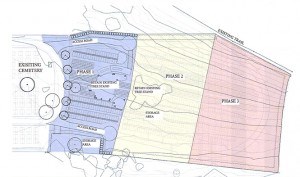
Jasper’s cemetery will need to be expanded within the next 10 years to keep up with demand, according to recommendations made to council, May 9.
On average there are approximately five burials per year and there are 60 plots still available leaving enough capacity for the next seven to 10 years.
According to the report, additional space may be available within the existing cemetery using infill, but in either case the cemetery will need to be expanded sooner rather than later. As of May 1 there’s already been three burials and five cremations in 2017.
To ensure there is enough room in the future, the consultant’s report suggested expanding the cemetery north in three phases that will provide enough capacity for the next 200 years. The entire expansion would increase the cemetery by 1.2 hectares.
“We worked hard with the municipality to put together a plan that we see as a viable option for many years to come and balancing that with the economic needs of the community,” said Tenille Thompson, a landscape architect with WSP Engineering.
The estimated cost to complete the first phase of the project is $302,000, which administration hopes to begin saving for by setting aside approximately $45,000 in reserve funds in the 2018 budget.
The entire project is estimated to cost approximately $1 million, but will be developed based on the municipal budget and community needs.
“The important part of this exercise at this point is to know what we need for the future and what those associated costs are and then we can begin putting reserves away for that period,” said Bruce Thompson, director of operations.
The detailed design drawings for phase one include additional burial areas, the retention of a large tree stand, an access road on both the east and west sides, space for seating areas, additional storage space for equipment and site materials as well as perimeter fencing and irrigation.
The design also includes a selection of different burial options.
“There’s full burial plots with upright markers and there’s full burial plots with flat markers on the surface of the ground and then we’ve got a couple options for cremation sites,” said Tenille.
Near the existing tree stands there are also a couple of options to install a columbarium to hold cremated remains.
“In addition to these detailed design drawings we put together a best practices document,” said Tenille. “That document looked at other municipalities in terms of what people are doing for equipment needs and for burial options. We also looked at software and provided recommendations for keeping records of the site and tracking for people’s families.”
Part of that review also included examining emerging trends in burials, including green burials and cremation practices.
According to Tenille, there’s a growing trend to be buried under trees or having a place marker on a rock.
“A lot of people are moving away from that full burial practice and moving towards cremations and putting their remains in columbariums as well as green burials.
“What we’ve done is we’ve planned based on existing cultural needs, however there’s options within that framework to reduce the size and scope. For example, in phase two that’s we made sure to retain those existing tree stands because that can really be advantageous when it comes to green burial practices.”
Paul Clarke
[email protected]
